December 30th, 2023-January 3rd, 2024
Researching online, it looked like the best, and supposedly
safest way to get to Lamu was by taking a short 25-minute flight from Malindi,
a small city about an hour north of Kilifi, where I spent Christmas. I grabbed a motorcycle taxi from Distant
Relatives, who took me to the matatu stop on the highway. There were a few vans loading up and 3-4 guys
were trying to persuade me to get in their vehicle, saying they were leaving soon,
and that I could have the front seat, etc.
They were borderline yelling at me, and I was not in the mood for
that. Even though it was a short ride to
Malindi, I decided that a more expensive (maybe $20 more) ride with my boda
boda guy would be much more enjoyable…and it was. It's a nice way to look at the passing
scenery on the back of a motorcycle versus a jam-packed van.
A nice baobab tree on the way:
I was dropped off about 100 meters from the airport and
passed by a security gate. A policeman
who was sitting in a plastic chair outside of the guard post asked me for my
passport. Then he escorted me towards
the airport, which seemed like nice service but then he started asked me to buy
him a Christmas beer or two from me. His
breath smelled like he’d already celebrated the festive season!
The waiting area in the airport:
It was a short but sweet flight on a Fokker 50, a plane I’ve
never been on before. It’s a turboprop
plane that can probably seat around 50 people and it wasn’t quite full, so I
was able to move to a window seat and enjoy the views of the Kenyan coastline.
The Lamu airport is on Manda Island that is virtually uninhabited since it is marshy and swampy land. I asked a security guard how one gets across to Lamu Island and he started to escort me towards the exit. Within 10 seconds I saw a man holding a sign with my name on it. I guess the place I’m staying at sent someone to get me. It was a ten-minute boat ride to cross over to the island where I was greeted by this older man, probably in his early 70s who introduced himself as Ziwa. His name would be easy to remember as it was the same as the rhino sanctuary in Uganda where I almost got trampled by a couple of rhinos. Ziwa led me on a five-minute walk to Jannat House, my home for the next five days.
As I mentioned, there are no cars or trucks in Lamu, but
there is the odd motorcycle, tuk tuk and tractor (for hauling around goods on
the promenade that have been shipped over from the mainland). Ziwa also pointed out the “donkey
taxis”. Yup, donkeys play a key role
here in transporting goods, and the odd lazy person.
Arriving at Jannat House, I was shown my room and then met
back up with Ziwa by the pool. He ran
through six different options of activities that I could do during my
stay. To me, the first logical one was
to go on a walking tour in the morning, to get the lay of the land. In the afternoon I would have to check over
my bookkeeping and submit it as it would be due.
My room:
Ziwa came to Jannat House at 9 am and we began our almost
two-hour walk around Lamu Town. Most of
the time I’d be trailing about 10 feet behind him. Not because I’m slow, but most of the narrow
paths don’t allow for people to walk side by side. We walked down one of the “main” streets,
which was maybe 3-4 persons wide at times.
Down by the waterfront:
Walking down one of the main streets:
One of many fancy doors on the tour:
As I mentioned, there are no cars or trucks in Lamu, but
there is the odd motorcycle, tuk tuk and tractor (for hauling around goods on
the promenade that have been shipped over from the mainland). Ziwa also pointed out the “donkey
taxis”. Yup, donkeys play a key role
here in transporting goods, and the odd lazy person. Due to the regular donkey traffic, I had to
keep one eye on the ground to make sure I wasn’t stepping in a fresh poo. I later asked Ziwa if the town had anyone
pick up the donkey droppings, but he didn’t really answer my question.
Taxi anyone?
Another stop was the Lamu Fort, but we seemed to just skip
by it to go into the market. I figured I
could return to it on another day.
Nearing the fort from the side:
Ziwa has been a tour guide for 30-40 years, so it wasn’t
surprising that there were many locals saying hi to him or having a quick,
passing conversation. We walked more
inland, and a bit uphill, to the biggest mosque in town. But it was closed too, so we didn’t go in. Behind the mosque was an area of recently
constructed buildings (in the last 30-40 years, not 300-400 like a lot of the
rest of Lamu).
The Riadha Mosque:
Another “stop” on the tour, was to go into a historic
home. Ziwa knocked on the door of this
one place, which was pretty fancy looking, complete with security cameras, but
the guy who eventually came to the door told him in Swahili that it wasn’t
possible for us to visit that day, who knows why. So we went to another place that Ziwa said
normally costs 500 shillings (about five bucks) to enter, but for me to not
worry as he would cover it. Well, I’m
glad he did. Sure, it was a glimpse at a
traditional Muslim home from a hundred or more years ago, but it was pretty
lame. We spent less than 10 minutes
there and it was very underwhelming.
These are walls made from coral, which is no longer allowed. They didn't know any better 300-400 years ago...
We returned to the shoreline and passed by a pen with 4-5
bulls in it. Right nearby was a
slaughterhouse and Ziwa explained that it was the cattle’s last day. They had just been brought over from the
mainland that morning and would meet their demise tomorrow.
Around that area, also back up by the mosque towards “new
town” and down by the beach, the amount of garbage, especially plastic, was
terrible to see. The tide was out and it
was like a garbage dump along the coastline.
Come on people. Rwanda has
figured the trash situation out…you can too.
The tide was out:
At the end of the tour, we sat down for a few minutes in a
restaurant by the water and discussed what I could do in my upcoming days. For the next day, we decided on going out on
a dhow, the traditional
sailboat in this area, to do a few hours of fishing, then head to a beach to
have lunch (hopefully cooking my catch) and then a bit of sailing to come back
to Lamu. It sounded great but my body
had different ideas. I’ve been wrestling
with possible Red Eye (conjunctivitis) on and off since I was in Rwanda. In Nairobi, I went to a pharmacy and got some
over-the-counter anti-biotic eyedrops.
They seemed to help, and I thought my problem was behind me, but it
flared up again around just after Christmas and now that I’m here in Lamu.
Thus, I postponed the fishing/sailing trip as I can’t wear
my contacts and I’m a real wimp when it comes to bright light. Not being able to wear sunglasses would not
be fun on the water, and I wouldn’t really be able to enjoy the beach time.
So not only am unable to do much for a few days here, but it’s
hot and humid, and the options for food (especially a decent lunch) are very
limited in Lamu. There are no grocery
stores either. Hence my title: Lame-u.
It’s not totally the place’s total fault, but I can’t say I’d want to
live here. I was surprised during the
walking tour when Ziwa was pointing out various homes and saying “Foreigner,
foreigner, foreigner.” I found it hard
to believe that these people, mainly Europeans, would really want to purchase
property and spend time here. For me, 5
days is about 3 days too many…but different strokes for different folks I
guess.
I’m looking forward to getting back to Kilifi…I just hope my
eyes are okay and I can do some more kite surfing lessons. Otherwise, I’ll be heading into Mombasa to
try and find an ophthalmologist.








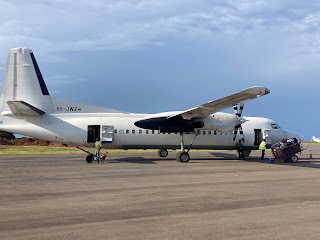








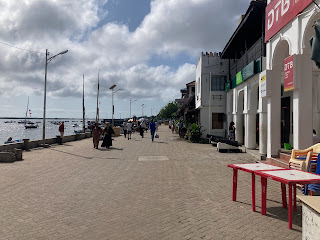

















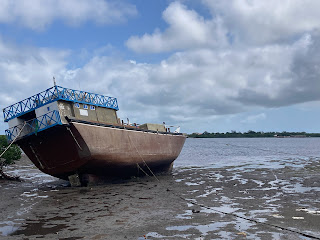


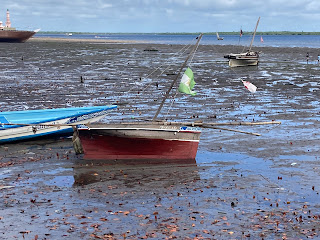
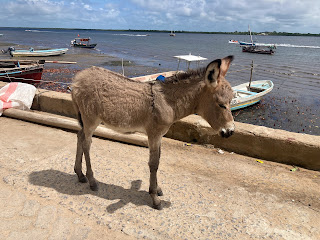



No comments:
Post a Comment